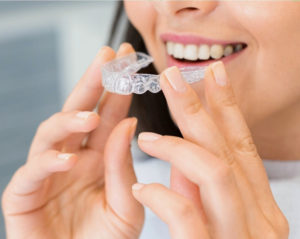 If you’ve started your journey to a straight smile with Invisalign, you’ve made a great investment. You won’t have to worry about the appearance of brackets or wires when fixing your bite and alignment. However, there are a few things you should know to ensure there aren’t any unexpected complications along the way. Here are the top do’s and don’ts of Invisalign.
If you’ve started your journey to a straight smile with Invisalign, you’ve made a great investment. You won’t have to worry about the appearance of brackets or wires when fixing your bite and alignment. However, there are a few things you should know to ensure there aren’t any unexpected complications along the way. Here are the top do’s and don’ts of Invisalign.
How Invisalign Works
Traditional braces use wires and brackets to move teeth slowly. Invisalign works differently. A series of clear plastic aligners are fabricated to be worn over your teeth to apply continual pressure to reposition them gradually. Each aligner moves your teeth in small increments using a discrete and comfortable method.
Do’s of Invisalign Treatment
The average treatment with Invisalign takes 12 to 18 months, but many factors affect your timeline. You can ensure there aren’t any delays in the process by following a few tips:
- Commit to Wearing Your Aligners: You must wear your aligners for at least 22 hours per day.
- Switch Your Aligners On Time: Your orthodontist will instruct you to switch your aligners every 1-2 weeks, depending on your treatment plan.
- Brush and Floss: Good oral hygiene is essential while wearing Invisalign. Brush and floss your teeth after every meal.
- Stay Hydrated: Drink plenty of water to stay hydrated and keep your mouth moist. Every sip will also cleanse your mouth in between brushing and flossing.
- Keep Your Aligners Clean: Clean your aligners using a soft-bristled toothbrush and clear antibacterial hand soap or dishwashing liquid before putting them in your mouth.
- Maintain Your Appointments: You won’t require appointments for adjustments, but you’ll still need to visit your orthodontist every few weeks to monitor the progression of your treatment.
Don’ts of Invisalign Treatment
You can prevent unnecessary complications during your treatment by avoiding:
- Switching Aligners Too Soon: Changing your aligners too soon won’t give your teeth enough time to move correctly, which can cause serious damage during the process.
- Wearing Your Aligners When Eating or Drinking: Your aligners are durable, but they can be damaged or stained if you wear them when eating or drinking anything except water.
- Using Abrasive Dental Products: Abrasive dental products can scratch your aligners, causing them to lose their translucent appearance. Food particles and plaque can get trapped in small scratches, leading to unpleasant odors, discoloration, and damage to your aligners.
Invisalign is a big commitment. Don’t let simple mistakes cost you down the road. With the correct care, you’ll achieve a straight smile quicker, with no preventable complications.
About Dr. Sean Willcutts
Dr. Willcutts is a board-certified orthodontist. He earned his dental degree from the Boston University Goldman School of Dentistry and continued his education for 3 years to specialize in orthodontics. He has also completed advanced training in cosmetic dentistry and smile design. Request an appointment through his website.
